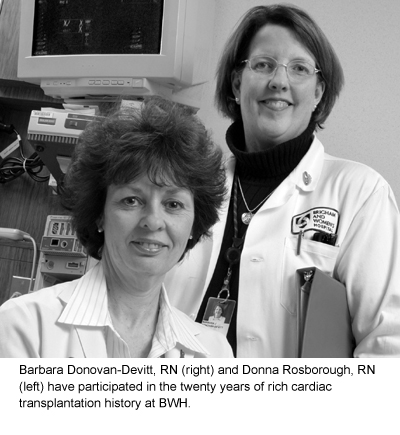A Look Back at History in the Making

OR staff involved in the historic 1984 heart transplants.
Some of the clinicians involved in the first heart transplant in New England at BWH today
Two BWH nurses reflect on their experience with the first heart transplant in New England
On February 2, 1984, Brigham and Women’s Hospital enjoyed its first nationally recognized milestone when a 43-year-old man became the recipient of New England’s first transplanted heart—a monumental event that was closely followed by a second heart transplant just eight days later. BWH Nurse sat down with Donna Rosborough, RN, MS, and Barbara Donovan-DeVitt, RN—co-nurses-in-charge for the cardiac surgical ICU and step-down units at the time—to find out what it was like to be a part of this clinical triumph first-hand. Both nurses continue to play vital roles in the Cardiovascular and Cardiac Surgery arms of the organization today.
“Both transplant patients went through an incredible journey from start to finish, and it was the nurses who really guided them through it,” said Donovan-DeVitt, who likened the role of the nurse to that of the axel of a wheel. “The various aspects of patient care revolved around the nurse, as we were the caregivers on the frontlines of pre- and post-operative care for these patients.”
Nurses continue to play a similarly intricate role in the pre- and post-operative care of heart transplant patients today, aided not only by new technologies and medications, but also by the perspective and knowledge of veterans like Rosborough and Donovan-DeVitt. “In retrospect, what we did was pretty amazing,” said Rosborough. “It has been very fulfilling to look back on this experience and see it in the greater context of our nursing careers.”
At the time, the average length of stay for a heart transplant patient was four weeks, with patients remaining in isolation throughout the duration of their hospital stay. Nurses—clad in precaution gowns, caps, gloves and shoe covers—often served as the only regular points of human contact for these patients, and as a result, wore many hats to fulfill the patients’ many needs.
Nurses functioned as care coordinators, arranging everything from Psychiatry and Nutrition visits to exercise time with physical therapists. “We would literally schedule the patient’s entire day, making sure time was allotted for each clinical visit, as well as for room cleaning, which was conducted twice a day by housekeeping,” said Rosborough, who even recalls scheduling time for patients to rest.
They also served as key educators, providing lifesaving teaching and instruction to patients and their families on each medication and about the many side effects that were associated with heart transplantation. “Heart transplant patients essentially traded a chronic illness for another chronic, albeit healthier, situation, and it was often very difficult for them to transition into this new phase of their lives,” said Donovan-DeVitt. “For example, a patient could not be discharged until they mastered the instructions associated with all required medications—about ten different ones— administered multiple times each day.”
In addition, nurses played a prominent role in the assessment of each heart transplant patient. “In the 1980s, this was new territory for us all. The physicians definitely looked to us for input about these patients, as we spent the most time one-on-one with them,” said Rosborough. “Our observations helped fill in the blanks with a nursing perspective, where the physician perspective might have left off.”
Over the past 20 years, Rosborough and Donovan-DeVitt have seen the overall care for heart transplant patients change significantly. Today, patients are generally transferred out of the ICU one day after their surgery and can be ready for discharge in as few as ten days. They are no longer required to remain in isolation for an extended period of time. And while heart transplant patients still take up to ten medications multiple times each day, many of those medications have been upgraded to easy-to-take capsule form.
“When compared to heart transplant patients 20 years ago, it seems as though patients today are in-and-out of the hospital,” said Donovan-DeVitt. “New and exciting advancements have really changed the way we care for heart transplant patients, and I feel so fortunate to have had the opportunity to witness it all from the very beginning.”